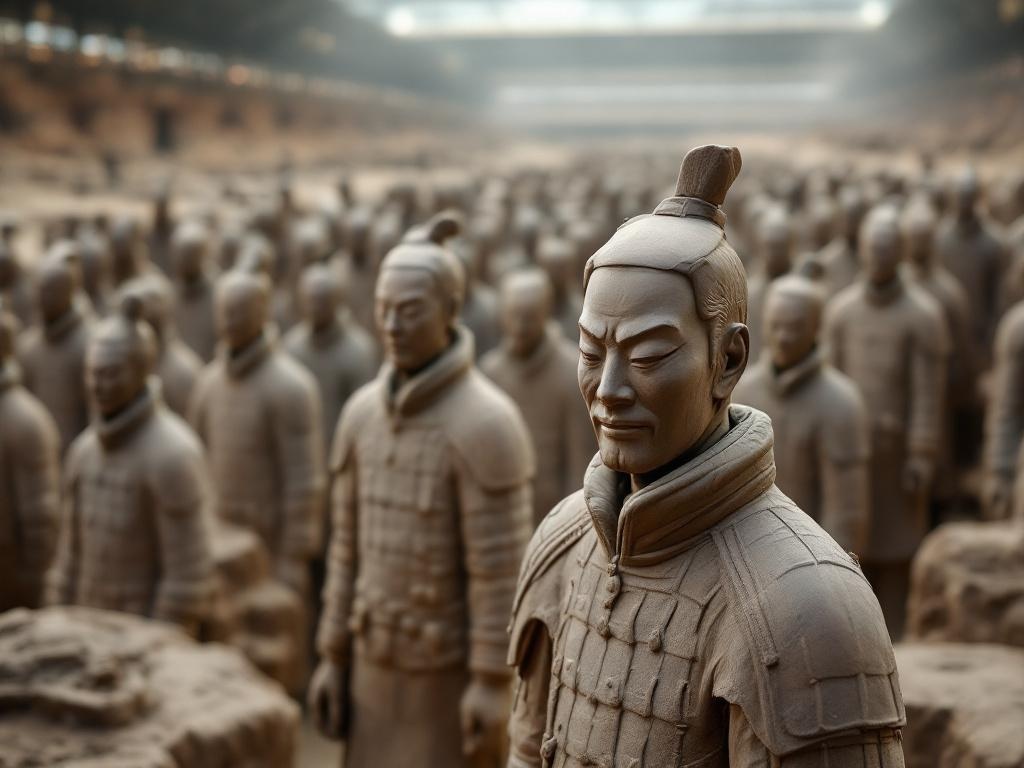Visiting the Terracotta Army in Xi’an
Journey back in time to ancient China and witness the awe-inspiring Terracotta Army, a UNESCO World Heritage site. Discovered in 1974 near Xi’an, these thousands of unique terracotta soldiers, horses, and chariots guard the first Emperor’s afterlife. Explore the vast pits, learn the captivating history, and plan your visit with our comprehensive guide. Discover the best times to visit, transportation options, ticket information, and insider tips for an unforgettable experience. Start planning your adventure today!
Important information

- The Terracotta Army, located in Xi’an, China, is a vast collection of terracotta sculptures depicting the armies of Qin Shi Huang, the first Emperor of China.
- Discovered in 1974 by local farmers, the army includes thousands of life-sized soldiers, horses, and chariots, offering a unique glimpse into ancient Chinese artistry and burial rituals.
- The museum is open from 8:30 am to 5:00 pm daily. Plan for a 2-3 hour visit to explore the three main pits. Spring and autumn offer the best weather for a visit.
- Various transportation options are available, including public and tourist buses, taxis, and guided tours. Guided tours offer historical insights and convenient transportation.
- Tickets cost ¥120 for the main exhibits. Additional tickets are available for other areas like the Lishan Garden and Emperor Qin Shi Huang’s Mausoleum.
Introduction to Visiting the Terracotta Army in Xi’an
Qin Shi Huang’s Terracotta Army is a remarkable sight and a UNESCO World Heritage site located in Xi’an, China. This discovery, considered one of the 20th century’s most important archaeological finds, features thousands of uniquely sculpted soldiers and has significantly altered our understanding of ancient China.
What is the Terracotta Army?
Unearthed near Xi’an in 1974, the Terracotta Army is a stunning collection of terracotta sculptures depicting the armies of Qin Shi Huang, the first Emperor of China. These life-sized figures, including soldiers, horses, and chariots, were entombed with the emperor to safeguard his journey into the afterlife. The sheer scale of the army, numbering in the thousands, is awe-inspiring, a testament to ancient Chinese artistry. Pit One, in particular, offers a remarkable spectacle, with ranks of warriors arrayed in battle formation.
Historical Significance and Discovery
In 1974, a remarkable discovery unfolded near Xi’an, China. Local farmers, digging a well, stumbled upon the now-famous Terracotta Army, forever changing our understanding of archaeological history. Thousands of life-sized terracotta soldiers, along with horses and chariots, emerged from the earth, offering a unique glimpse into ancient China. These figures showcased Emperor Qin Shi Huang’s military might and the elaborate burial rituals of the third century BCE. The army’s intricate craftsmanship and sheer scale are testaments to the emperor’s influence and the advanced artistry of the Qin dynasty. Ongoing excavations at the site continue to unearth new insights into this fascinating ancient civilization.
Why Visit the Terracotta Army?
Journey back in time and encounter the magnificent Terracotta Army. These life-sized warriors offer a captivating glimpse into China’s rich imperial history. Their imposing presence evokes the weight of centuries past. Enhance your visit with a guided tour for deeper insights into this ancient wonder.
Explore the three main burial pits, each holding unique formations of warriors and artifacts.
Visit the on-site museum to witness the meticulous excavation and preservation efforts that have brought these ancient figures to light.
Consider a guided tour to gain deeper insights into the history and significance of the Terracotta Army.
Discovering the Terracotta Army is an unforgettable experience. Before you travel, make sure you have the necessary visa or permits. Check the latest entry requirements here: Find out entry rules for your destination.
Planning Your Visit to the Terracotta Army
For a pleasant visit to the Terracotta Army, plan your trip during spring (April-May) or autumn (September-October). These seasons offer comfortable weather and fewer crowds.
Summer (June-August) can be hot and humid, while winter (November-March) is quite cold.
Exploring the Terracotta Army Museum, including its three main pits, typically takes 2-3 hours.
Consider extra time for the museum exhibits and other nearby attractions.
Visiting early in the day or later in the afternoon can offer a less crowded experience.
Best Time to Visit
Enjoy perfect weather during spring or autumn. For a crowd-free experience, arrive early – ideally at 8:30 am when the museum opens.
How Long Does It Take to Visit?
Plan your visit to the Terracotta Army, allotting 3–4 hours to fully experience the museum and the mausoleum. Marvel at the impressive warriors and uncover their captivating history. It’s a truly memorable experience.
What to Expect: Weather and Crowds
Xi’an has four distinct seasons. Summers are hot and humid, with average temperatures around 86°F (30°C). Winters are cold and dry, averaging about 34°F (1°C). Spring and autumn offer milder weather, making them popular tourist seasons. Therefore, attractions like the Terracotta Army are busiest during public holidays and peak seasons (July-August and October). Arriving early is recommended to avoid large crowds.
Getting to the Terracotta Army
Traveling to Xi’an’s Terracotta Army is easy, with several transportation options available. Public buses are a budget-friendly choice, departing regularly from Xi’an’s main station. For added convenience, tourist buses often include hotel pickup and drop-off services. Taxis offer a direct route, taking approximately 40 minutes, but travel time may vary due to traffic. Guided tours provide transportation combined with expert commentary on the historical significance of the site and frequently include visits to other nearby attractions.
Transportation Options from Xi’an
Xi’an Railway Station’s East Square offers convenient access to public and tourist buses, providing excellent transportation choices.
Public Bus and Tourist Bus Services
Traveling to the Terracotta Army Museum is budget-friendly using public transport. You can take the bus number 5, which departs from Xi’an Railway Station’s East Square. Alternatively, tourist buses offer convenient pickups from various locations across Xi’an, including hotels and popular tourist spots, often providing a more direct route to the museum.
Guided Tour Options and Benefits
Enhance your Xi’an adventure with a guided tour offering convenient pick-up and drop-off service. Local guides provide invaluable historical insights, enriching your visit with fascinating stories and context. They also offer helpful logistical advice and navigate the site efficiently, saving you time and stress. This all contributes to a smoother, more enjoyable experience. A guided tour offers several key benefits:
- Convenient transportation: Enjoy hassle-free pick-up and drop-off, eliminating transportation worries.
- Expert insights: Benefit from local guides’ in-depth knowledge of history and culture.
- Efficient navigation: Save time and avoid stress with a guide who knows the site inside and out.
Ticket Information and Opening Hours
Plan your visit to the Terracotta Army Museum. Standard entry tickets to the main exhibits start at ¥120. For a complete experience, consider a combined ticket that includes access to the museum and the scenic Lishan Garden. Separate tickets are also available for the exhibition hall and Emperor Qin Shi Huang’s Mausoleum.
Museum Opening Hours
The museum is open daily from 8:30 am to 5:00 pm, with last entry at 4:30 pm. This schedule is consistent throughout the year.
Closures
The museum is generally open year-round. However, occasional closures may occur for national holidays. It’s always best to check the museum’s website for updates before your visit.
Ticket Prices and Options
Entry to the Terracotta Army Museum costs 120 CNY, granting access to its primary exhibits.
Opening Hours of the Museum
The Terracotta Army Museum is open daily from 8:30 a.m. to 5:00 p.m., so plan your visit accordingly.
Guided Tours vs. Self-Guided Visits
Guided Tours
Delve deeper into history with the convenience of pre-planned itineraries. Logistics are handled for you, simplifying your trip.
Self-Guided Adventures
Embrace the freedom of personalized exploration. Control the pace and focus on what excites you, tailoring the experience to your travel style.
Advantages of Hiring a Local Guide
Local guides enhance the Terracotta Army experience by offering a more personalized and in-depth encounter. They steer visitors away from crowds, allowing for a closer look at the figures. They provide valuable historical context and answer questions, fostering a deeper understanding of the site’s significance. For example, a guide might explain the soldiers’ varying ranks or highlight unique details, tailoring their commentary to individual interests. Choosing a knowledgeable guide is essential for a truly enriching visit.
Exploring on Your Own: Self-Guided Tips
Embark on your pit exploration at Pit 2, showcasing specialized exhibits. Then, proceed to Pit 3 for a deeper dive into specific collections. Finally, experience the awe-inspiring main attraction at Pit 1, the culmination of your journey. This carefully planned sequence maximizes your experience by building anticipation and creating a memorable visit.
Understanding the Layout of the Terracotta Army Museum
Pit One, the largest, contains the main army, a complete battle formation of infantry, chariots, and cavalry.
Pit Two features smaller units and specialized troops, highlighting the army’s diverse composition.
The smallest, Pit Three, likely served as a command post for high-ranking officers.
The Warrior Hospital exhibit reveals insights into ancient Chinese medicine and the army’s healthcare practices.
Pit One: The Main Attraction
Pit One, the largest of the Terracotta Army pits, is a breathtaking spectacle. It contains the majority of the soldiers and displays the army’s main battle formation, with rows of infantry poised for action and chariots arrayed for combat. This pit is the site’s main draw, an absolute must-see for any visitor.
Pit Two and Pit Three: Additional Discoveries
Pit Two, filled with kneeling archers, showcases the army’s ranged attack capabilities. Pit Three, likely the command post, contains high-ranking officers and evidence of complex battle formations. These discoveries highlight the army’s diverse composition and strategic prowess.
Visiting the Warrior Hospital
The warrior hospital, located at the back of Pit One, showcases intriguing Qin dynasty medical artifacts. These artifacts offer a glimpse into the army’s healthcare system, providing insights into the warriors’ lives and the army’s dedication to their well-being. This exhibit offers a compelling look into the past, emphasizing the importance of medicine during wartime.
Accessibility and Visitor Tips
The Terracotta Army Museum offers accessible features for all visitors, including on-site wheelchair rentals, accessible restrooms, ramps, and designated parking.
Start your visit at Pit 1, the largest and most impressive excavation site. It houses the majority of the terracotta soldiers and chariots.
Continue to Pits 2 and 3. These pits showcase the command post, infantry units, and other fascinating aspects of the army.
Consider hiring a guide to enrich your understanding of the historical and cultural significance of the Terracotta Army.
Wear comfortable shoes, as you’ll be doing a lot of walking. The museum covers a large area, and exploring all the pits takes time.
Stay hydrated throughout your visit, especially during hot weather. Carry a water bottle and refill it as needed at designated water stations.
Arrive early, particularly during peak season, to avoid large crowds and enjoy a more comfortable experience. This will allow you ample time to explore the exhibits.
Follow the designated paths and maintain a respectful distance from the artifacts. This helps preserve the historical site and ensures a safe and orderly experience for all visitors.
Refrain from touching the terracotta figures to prevent damage and preserve these invaluable historical artifacts for future generations.
Accessibility Information for the Museum
The Terracotta Army Museum offers a smooth and accessible path, guiding visitors directly from the entrance to the main excavation pits for effortless navigation.
Tips for Navigating the Site Efficiently
For a more enjoyable visit, follow these guidelines:
Stay on designated paths.
Admire sculptures from a safe distance.
Refrain from touching the artifacts.
Consider hiring a local guide to discover hidden gems and enrich your experience.






